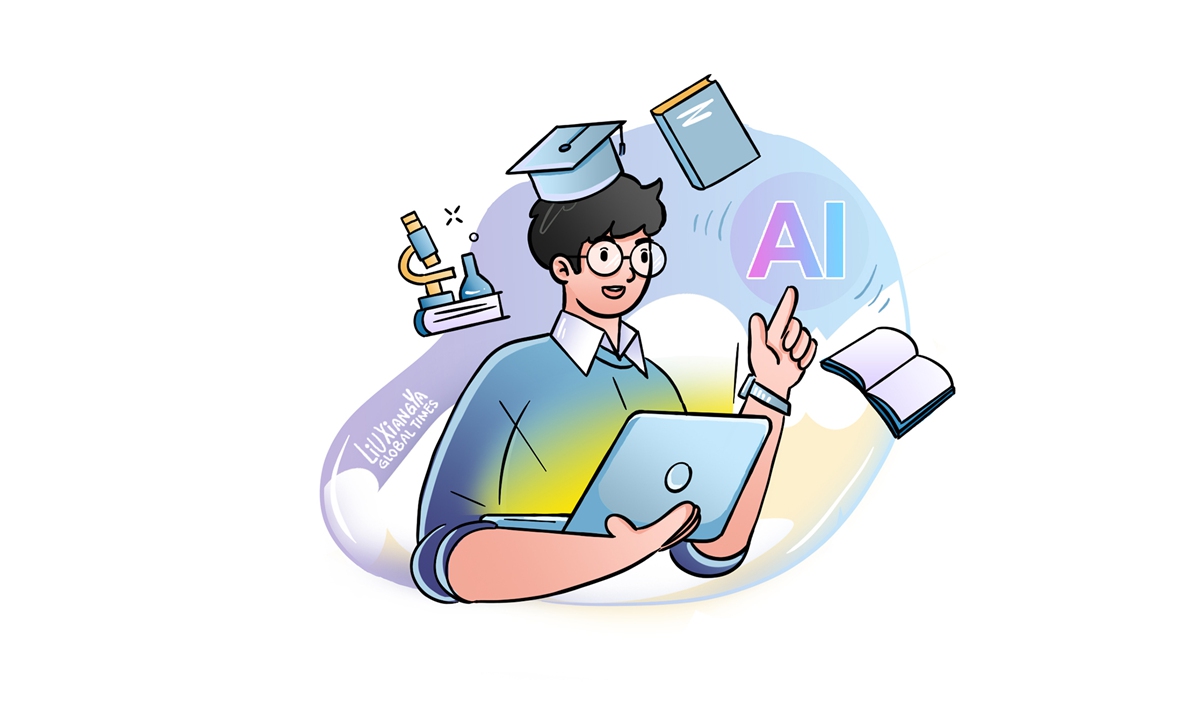
Illustration: Liu Xiangya/Global Times
The AI chatbots are having a bigger impact on higher education. Among the soaring number of chatbot portal users worldwide, many of them are on their way of pursuing higher education. The AI tools can answer questions and generate slick, well-structured blocks of text several thousand words long on almost any topic it is asked about. It was once widely condemned as a free essay-writing and test-taking tool to cheat on assignments.
However, attitudes toward it are shifting, primarily among higher education institutions.
On June 29, the Hong Kong University of Science and Technology took the lead as the first university in Hong Kong to provide access to AI tools. It officially launched its AI chatbot, which aims to provide all university members with a safe and usable AI chatbot tool. The Education University of Hong Kong announced this March that it welcomed students to use AI tools in their courses and will incorporate testing tools to ensure academic integrity.
Li Zijian, vice president of the University, said that as the emergence of AI technology has brought tremendous changes to traditional teaching, teachers should be more proactive than ever in acting as facilitators to enhance students' understanding of the advantages and limitations of AI, and to enable students to use technology accountably.
Russell Group's universities in the UK also issued principles on the use of generative AI tools in education and allow students and faculty to use AI technology under such guidelines.
These measures reflect that with the continuous technological development, the relationship between AI and higher education has undergone subtle changes.
Some researchers in higher education have seen the use of AI as dangerous behavior. However, Vaughn Connolly, a researcher at the University of Cambridge, says that how to use AI safely, effectively, and appropriately is an urgent issue. Any ignorance or negligence will put them and their students at a disadvantage. Thus, how AI can be incorporated into higher education better has become a major question.
First, AI may contribute to scientific progress, which higher education longs for in training talents. For example, "literature-based discovery" (LBD) involves analyzing existing scientific literature, using chatbot-style language analysis, to look for new hypotheses, connections, or ideas that humans may have missed.
LBD is showing promise in identifying new experiments to try - and even suggesting potential research collaborators. This could stimulate interdisciplinary work and foster innovation at the boundaries between fields. LBD systems can also identify "blind spots" in a given area and predict future discoveries and who will make them. This can turbocharge scientific progress and lead to a golden age of discovery.
Second, AI tools may help develop critical thinking, a key in higher education.
Data and information contained within generative AI tools are garnered from various sources, including those that could be referenced or corrected. Besides this, it produces answers based on human data, which may contain societal biases and stereotypes that may be replicated in the generative AI tool's response.
Therefore, we need to learn how to differentiate and discern the content provided by AI with a critical attitude. The role of teachers is shifting. They are more of a facilitator of information than a gatekeeper. Teachers must now show students how to find information, what to trust and what not to, and how to tell the difference and see the shortcomings.
AI chatbots may also improve efficiency and optimize the learning experience. They could be powerful classroom aids that save teachers time on admin, teach students media literacy, and generate personalized lesson plans. For instance, AI can free professors and lecturers from mundane tasks like preparing syllabuses and course design work.
In addition, AI can make the teacher-student ratio reach 1:1 and work for students 24 hours a day. Moreover, such software tools can provide made-to-measure learning assistance so students can learn at the most suitable pace. Educational tech companies such as Duolingo and Quizlet, which make digital flashcards and practice assessments, have already integrated AI chatbot into their apps.
Accordingly, for better use of AI, universities will bear corresponding responsibility in the following areas. One is to support students and staff in becoming AI-literate and understanding the application, opportunities, and limitations associated with using these tools. The other is to ensure academic integrity and the ethical use of AI by regularly evaluating policies and principles for staff and students relating to generative AI tools and their impact on teaching, learning, and assessment practices and cultivating an environment where students can ask questions about specific cases of their use and discuss the associated challenges. Indeed, educators will need time and resources to innovate in this way.
The author is a faculty member with the School of Applied Economics, Renmin University of China. [email protected]
URL: https://www.seeglobalnews.com/read-2447.html